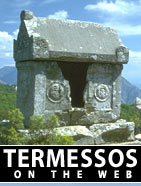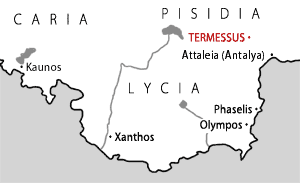


This website sorts and describes every history, travelogue and photo gallery I could find. It includes 50 links and 102 pictures of the site. These are divided into About Termessos, Travelogues and Photos, Tourism, and pictures of the theater and the rest of Termessos.

A Short History of Termessos
Termessos (also known as Termessus) was inhabited by the Pisidians, an indigenous Anatolian nation of noted ferocity. The city first appears in history during the conquests of Alexander the Great. Alexander swept through the region but after winning a skirmish in the narrow mountain passes near the city, declined to storm it. (Guidebooks consistently portray Alexander as unable to take the city, but in fact he was merely disinclined to try.) After Alexander's death the city saw a famous clash during the wars of Alexander's "Successors." One of Alexander's generals, Alcetas, found himself trapped in the city by another of Alexander's generals, Antigonus the "One-Eyed." Beloved by the city's young people, Alcetas was betrayed by its "senior citizens" and comitted suicide rather than fall into Antigonus' hands. Mutilated and left unburied by Antigonus, Alceta's body was retrieved by the younger generation and given a hero's burial. The extant "lion sarcophagus" has convincingly been identified as his final resting place—among the only surviving graves of Alexander's friends and companions.
In the Hellenistic period, Termessos gradually "Hellenized," adapting Greek culture, language and even becoming a democracy. The impressive theatre was built during this period, no doubt serving as both entertainment venue and political meeting place. Throughout the period, Termessos was engaged in frequent warfare with its neighbors, often taking on more than one. For its help in his campaign against Selge (c. 158 BC), Attalus II of Pergamum erected the city's elegant stoa (porch).
Termessos passed easily into Roman friendship and later empire. The city received considerable autonomy for its role against King Mithridates. It guarded its privileges jealously; remarkably, its coinage never included either image or title of the Emperors. (This is the source of the tour-guide story that Termessos was never conquered by Alexander or the Romans!) Most of the city's buildings were erected in this period, including a temple to the Emperor Hadrian. At some point the city Christianized, and bishops from Termessos participated in the early church councils, but the city was abandoned between the 5–7 centuries. (Remoteness and earthquakes may have both played their part.) Except for the occasional nomad it lay empty after that, which explains its relatively pristine state.
For a more detailed account of Termessos' history, see the Wiki Classical Dictionary.
Get Involved!
I tried my damnedest, but there must be more. Send me your pictures, your travelogues—I will list anything relevant.
Thanks for coming!
Tim Spalding
Portland, Maine
[email protected]
Credits: Navigation bar photograph © Manfred Hiebl (www.manfredhiebl.de). Main-page photograph of the theater at Termessos © Jack Brauer (www.widerange.com). Map © Tim Spalding.

Photograph above © Manfred Hiebl (website). Used by permission.
All material © 2000–2005 Tim Spalding. Books presented in association with Amazon.com.
If you enjoy this site you may like this other site by me:
Alanya, Turkey on the Web. All about my favorite town, Alanya (which is near Termessos, past Antalya on the coastal road).
The Sumela Monastery on the Web. About the Sumela Monastery, near Trabzon on the Black Sea.